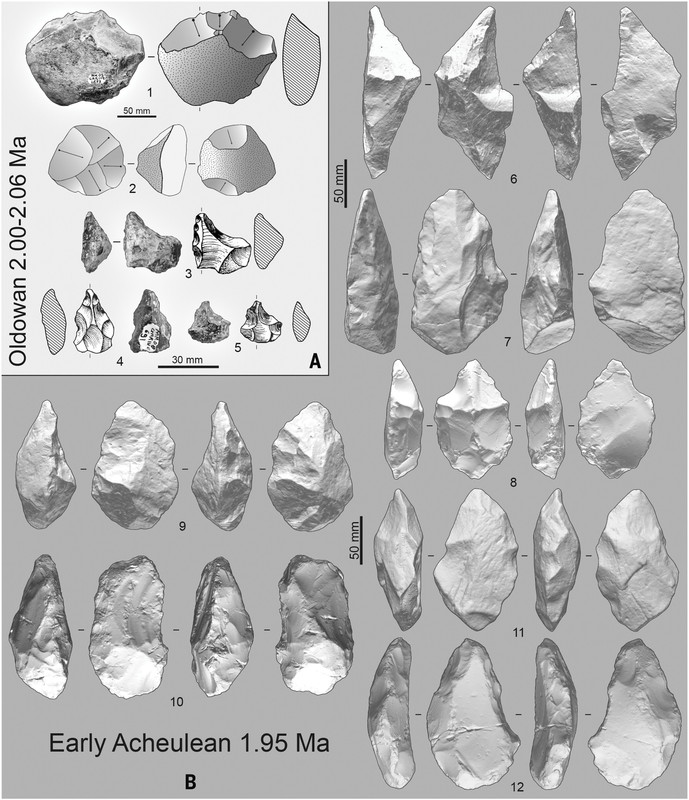Science
Related: About this forumEarly Homo erectus lived at high altitudes and produced both Oldowan and Acheulean tools
The paper to which I'll refer is this one: Mussi, Margherita, Skinner, Matthew M., Melis, Rita T., Panera, Joaquín, Rubio-Jara, Susana, Davies, Thomas W., Geraads, Denis, Bocherens, Hervé, Briatico, Giuseppe, Le Cabec, Adeline, Hublin, Jean-Jacques, Gidna, Agness, Bonnefille, Raymonde, Di Bianco, Luca, Méndez-Quintas, Eduardo, Early Homo erectus lived at high altitudes and produced both Oldowan and Acheulean tools, Science, 382, 6671, 713-718 (2023).
While trapped at a conference in DeSantis land, doing my best to do anything beyond the bare minimum to leave my currency in that hellhole of ignorance and racism, I read the first 150 pages of so of this book: Lone Survivors, How We Became the Only Humans On Earth. (Chris Stringer, 2012)
The book is well worth a read, if for nothing else for insights to methods of geological dating beyond those of which I was aware, but also as a not overly (but somewhat) technical view of human evolution.
Chris Stringer is a primary scientist working in the field.
An updated version of his book can be found here in another article in Science from 2018:
Galway-Witham, Julia, Stringer, Chris, How did Homo sapiens evolve? Science, 1296-1298, 360, 6395, 2018.
Anyway, from the link above, a few excerpts:
...Level E at Garba IV (now dated to ~2.00 Ma) was first tested in 1981, and 34 m2 were eventually exposed (fig. S4 and figs. S8 to S10), with an additional exposure of 12 m2 of underlying level F (now dated to ~2.02 Ma) (fig. S4 and figs. S8 to S10). Both yielded abundant Oldowan tools (7), and the associated mandible represents one of the only hominin remains directly associated with artefacts in the Early Pleistocene (table S1). It was excavated in level E, a sealed level within a well-established stratigraphic sequence (Fig. 1, C and D; fig. S2; and figs. S9 to S11). The artefacts were mostly produced on obsidian cobbles and pebbles preferentially selected from the rocks available in the local alluvial deposits (Fig. 2A and figs. S12 and S13). Many of these artefacts are made from small flakes, mostly 20 to 50 mm in length, with ~30% retouched and transformed into small, pointed tools (Fig. 2A, 3 to 5, and fig. S13)...
...The vegetation of the Garba IV site belonged to the dry evergreen Afromontane forest and grassland complex, which currently develops on the mountains of East Africa above 1800 m asl (9, 10). The palynology indicates the presence of bushy woodlands alternating with patches of grassland in the area of Melka Kunture at around 1.8 Ma or possibly earlier. (1). A more open vegetation and a mountain grassland followed, which further expanded during the deposition of level D at Garba IV. Afromontane vegetation develops under a mountain climate with large diurnal temperature ranges, resulting in plant species that are distinct from those of the lowland savanna or woodland...
Some graphics from the paper:

The caption:
(A) Location map of the Garba IV site (Melka Kunture, Upper Awash, Ethiopia). (B) The stratigraphy of the Garba gully, with both Garba IV and Garba XIII, a middle Acheulean site (42). Geomagnetic polarity timescale is from (43), 40Ar/39Ar dates are from (5), and K/Ar dates are from (44). (C and D) The stratigraphy of Garba IV and the paleomagnetic sequence of samples with normal (small black squares) and reverse polarity (small white squares) (6) (fig. S3).

The caption:
(A) Levels E and F (2.00 Ma to 2.06 Ma), Oldowan. Images show obsidian cores (1 and 2) and obsidian pointed tools (3 to 5). (B) Level D (1.95 Ma), Early Acheulean. Images show large retouched flakes shaped on basalt or obsidian (6 to 8) and handaxes shaped on lava, basalt, or obsidian flakes (9 to 12).
There is a nice discussion in the full paper, including commentary on the identification of H. Erectus by features of the fossil teeth, a topic covered very well in Dr. Stringer's book.
Have a nice day tomorrow.
Hekate
(94,648 posts)Hermit-The-Prog
(36,588 posts)Seriously, though, looking at those images it occurs to me that I'm probably surrounded by tools I'm just too ignorant to recognize.
littlemissmartypants
(25,483 posts)eppur_se_muova
(37,398 posts)It's not just that there are whole taxonomic orders known entirely, or almost entirely, from fossil teeth. It's also that the evolution of teeth actually may have driven the evolution of other distinctly "mammalian" features.
keithbvadu2
(40,111 posts)
NNadir
(34,662 posts)Genes are not exchanged in a linear fashion in sexual reproduction, but are exchanged in a sometimes circular fashion.
It is known, for instance, since the sequencing of neanderthal fossils that Europeans in particular carry some of the genes associated with our close relative species.
The contribution of Neanderthal introgression to modern human traits Patrick F. Reilly, Audrey Tjahjad, Samantha L. Miller, Joshua M. Akey, and Serena Tucci, Current Biology 32, R970–R983, September 26, 2022.